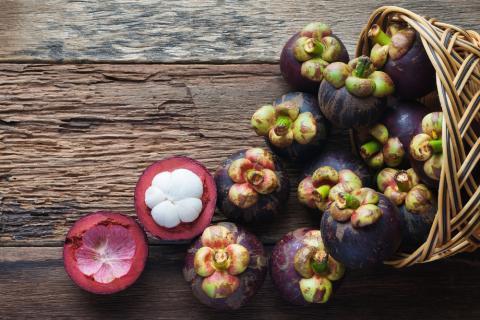
Up until recently, mangosteen was illegal to import into the United States. When I first moved to the U.S. from Canada, no one understood what I was inquiring after when I asked grocery stores if they carried this superfruit. In Vancouver, British Columbia, where I grew up, mangosteen can be bought at Asian grocers or large markets like the popular Granville Island, where I often bought this delicious fruit for special occasions. Where I first found out about them, in Tahiti, mangosteen is sold like green juice is in the U.S. -– in most major cities’ restaurants, cafes, and specialized juice bars. But mangosteen has yet to really be recognized for its powerful properties and delicious taste here in the U.S. Here’s everything you need to know about mangosteen.
What:
Originally cultivated in Southeast Asia (specifically the Malay Archipelago), mangosteen is a round, red fruit with four reddish green leaves on top, similar to those of the persimmon. Several countries in Latin America, including Costa Rica, Honduras, Brazil, and Panama, now grow mangosteen as well. The long cultivation period (between ten and fifteen years to grow a fruit) is off-putting to most commercial growers, which is part of the reason for the fruit’s high cost. The growing conditions also mean that location is limited: mangosteen trees need heavy rain, super high humidity, and lots of space; at maturity, they can be 40 feet tall and yield 1,000 mangosteens each year!
Where:
Mangosteen can now be purchased in the U.S., following irradiation protocols. While access to this fruit is now much easier, several health organizations have doubts about the safety of irradiation. The best place to buy mangosteen is from the source, which means you might have to wait until you travel, but several brands offer mangosteen juice, which is packed with antioxidants. Look for bottles that contain 100% pure mangosteen juice; the best companies come from overseas and places like Tahiti.
Why:
Mangosteen has recently become a superfruit, thanks to marketing companies that promote the fruit’s medicinal properties. Several websites suggest that this fruit:
- has cancer-fighting properties (thanks to the xanthones, and one in particular called Alpha-Mangostin)
- combats inflammation
- lowers blood sugar
- reduces skin conditions like eczema or acne
- regulates blood pressure
- reduces allergy symptoms (antihistamine properties)
Most importantly, mangosteens are delicious. Some people describe the taste like a combination of strawberries and peaches, while others swear they taste hints of plum or clementine. Several writers have written odes to the mangosteen in magazines and journals, like this one, this one, and this one. Do a simple search for “mangosteen” on the Internet and you’ll find a plethora of websites dedicated to the fruit, with just as many recipes. Several legends even tell of Queen Victoria offering large sums of money for just a taste of the fruit.
How:
Mangosteens aren’t as easy to eat as they may appear. For one, the outer skin can be tough. I find it helpful to cut the fruit at its circumference. Then simply slide off the top and bottom to reveal several white sections of fruit. Though you’ll find a list of recipes online for treats like mangosteen clafoutis, mangosteen smoothies, mangosteen ice-cream, and mangosteen pudding, the best way to enjoy mangosteen is fresh, raw and simply. Cut and enjoy.
What does mangosteen taste like to you?








